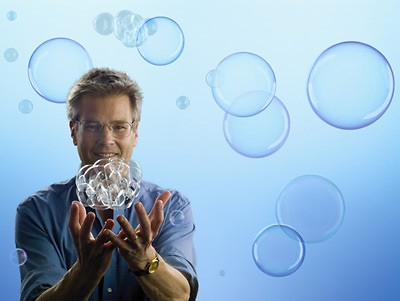Paul Steen's latest invention makes a walk on the ceiling not so far-fetched
By Kenny Berkowitz
Paul Steen's teenage daughters think it's funny their father earns his living playing with soap bubbles.
"Soap bubbles are simple but very effective," says Steen, a professor in the School of Chemical and Biomolecular Engineering. He uses them to study the reconfiguration of thin films by surface tension. But after studying them for the last dozen years, he has found that unpredictability reigns.
"The individual soap bubble is relatively well understood, but when you combine a group of them with different geometrical constraints, and when you let them work together or fight one another, you see them elucidating this wonderful set of instabilities. It's very dramatic, because there's a balance of forces, and then some disturbance comes to throw everything out of whack, and all of a sudden you've got … a catastrophe."
Unpredictability is at the mathematical heart of his two latest projects: an electrical switch made of water and a method for spin-casting metal in thin, continuous sheets.
The electrical switch, Steen believes, has enormous potential. Playing with a palm-sized prototype of the switch, he speaks of the thrill of harnessing the power of surface tension. In his electro-osmotic droplet switch, he uses electricity to create and release an adhesive bond between a droplet of water and a flat plate. It was originally inspired by Cornell entomologist Tom Eisner's description of how a palm beetle can cling to a leaf with a strength equal to 100 times its body weight -- the equivalent of Steen supporting six or seven cars with a bead of spit.
"The image of the beetle clinging and releasing itself stuck in my mind," says Steen. "And the more I rolled it around, while I was riding my bike or jogging or walking, the more I thought I should take a closer look at how we could put it to practical use."
The device has no solid moving parts, turns on and off in under a second, runs on less than five volts and can be used either by itself or in larger arrays. Engineered down to the hundred-nanometer scale (A nanometer is one-billionth of a meter, about as long as three atoms in a row), an array of switches could enable Steen to walk across the ceiling of his office, focus the lens of a cell phone camera, or act as a microscopic, energy-efficient lab-on-a-chip.
The implications are such that it's no surprise that the Defense Department's Defense Advanced Research Projects Agency has awarded Steen and colleagues a grant to demonstrate "capillarity-based reversible super-adhesion," an idea that can be illustrated with a bank of soap bubbles or liquid droplets controlled by electro-osmotic droplet switches.
"It's one of the most ingenious ideas that I've seen in a long time," says Paulette Clancy, the William C. Hooey Director of the School of Chemical and Biomolecular Engineering. "It is so clever and so thoroughly backed up with theory."
The device will be Steen's third patent. In the first, he designed a system for casting molten metal into thin, solid ribbons in a single step, manipulating the surface tension of the cooling, hardening metal on a rapidly spinning wheel. At a time when the world is focused on conserving energy, casting by design could become a huge boon to producers of flat products of aluminum and steel. For aluminum foil alone, the savings would amount to 300 gigawatt hours per year with a reduction of carbon dioxide emissions by 250,000 tons a year in the United States alone.
Growing up in the small city of Meadville, Pa., Steen had wavered between English, history, math and engineering. He graduated from Brown University in 1975 with a bachelor's degree in English literature and another in biomedical engineering. Two years after completing his Ph.D. in fluid mechanics at Johns Hopkins University in 1980, he joined the Cornell faculty.
He is associate editor of the Journal of Fluid Mechanics, co-author of more than 60 published articles and mentor to countless Cornell students, both undergraduate and graduate.
"You can try some of your riskiest ideas with undergrads," Steen says, "because their diplomas don't depend on the idea working out, and they're some of the best brainstormers you'll ever find."
John Faria '05, who worked for Steen as an undergraduate and is now in medical school, tells the story of successfully reverse engineering a bubble toy that Steen's younger daughter brought home from a birthday party. When Faria showed the results to Steen, "he was 10 times more excited than me. He just jumped out of his chair, landed on the floor and kept staring at this bubble. And that's the attitude he carried throughout the whole lab."
Steen and his family delight in biking or cross-country skiing around the Finger Lakes. The quiet moments between hills give Steen a chance to think through those next obstacles: a more uniform array of switches and a smoother ribbon of aluminum.
"I get an incredible thrill from doing this work," says Steen. "It's still amazing to me that we have this way of connecting numbers to physical phenomena. The range of predicting and understanding instabilities is just a fundamental fascination for me. And underneath it all, I like the idea of taking a mathematical proof and seeing it connect with something we can all use."
Kenny Berkowitz '81 is a freelance writer in Ithaca; this article was adapted from Cornell Engineering magazine.
Media Contact
Get Cornell news delivered right to your inbox.
Subscribe